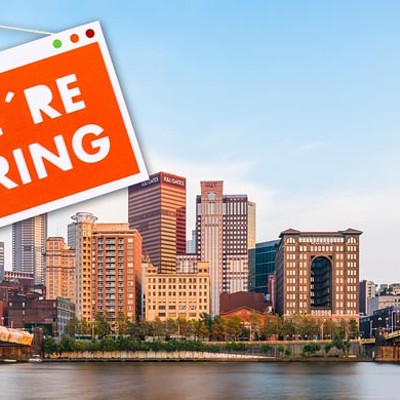You haven't seen these seals on other Pittsburgh bridges for a simple reason: Almost no Pittsburgh bridge was designed with as much consciousness of its own history.
Most bridges in Pittsburgh were dedicated with very prosaic names: Consider such flights of poetic fancy as the 16th Street Bridge, the 10th Street Bridge or the Highland Park Bridge. Some spans began with such everyday names, but -- in a desperate attempt to connect them to something other than the opposite river shore -- were later renamed after some local figure. I give you, for example, the "Roberto Clemente Bridge," né the Sixth Street Bridge.
The 40th Street Bridge, meanwhile, has followed the opposite path: Originally it was named after a cherished bit of local lore, but later became identified with a street number. The proper title for 40th Street was "Washington Crossing Bridge," so called because George Washington himself must have wished for it.
To hear the Daughters of the American Revolution tell it -- as they do on a plaque mounted on the structure -- Washington and "Christopher Gist, his guide, crossed the Allegheny River at the point on December 29, 1753 on the return journey from Fort LeBoeuf." But as is frequently the case with the DAR, the most interesting part of the story is left out. To say Washington "crossed" the river is a bit like saying George Bush "liberated" Iraq: It's a verb choice that conveniently omits the less-than-heroic nature of the enterprise.
The fact is, Washington and Gist nearly drowned trying to cross the Allegheny's icy waters in a raft. As Washington himself later wrote in his journal, "we were obliged, as we were near an Island, to quit our Raft and make to it."
County officials were apparently proud of nearly killing off the Father of Our Country, and sought ways to commemorate the event. According to a federal Historic American Engineering Record report, newspapers talked excitedly of plans to open the bridge in December 1924 -- on the "one hundred and seventy-first anniversary of the day George Washington crossed the swift running stream at that point." (Apparently, 171 was a figure of some significance amongst county officials. Perhaps they practice some esoteric form of kabbala, which would explain some of the mystery surrounding real-estate assessments.)
The question was how to capitalize on this history. Erecting a sculpture of two men nearly drowning, one supposes, probably would not have inspired much confidence among commuters using the bridge. So to give the structure a Colonial air, the bridge was decked out with 288 panels, each about 3 feet high and 2 feet wide, featuring the seals of the original 13 colonies and Allegheny County's coat of arms. The artist who created the panels is unknown, according to the book Discovering Pittsburgh's Sculpture, by Marilyn Evert and Vernon Gay. But they were unpainted until 1976, when a team of some 200 volunteers led by Shaler resident Stan Hubstenberger painted them over.
As local bridge guru Bruce Cridlebaugh points out on his Web site pghbridges.com, there is some logic to the arrangement of state seals. The sequence begins with the county seal, and then follows "roughly the same order as the states appear in the map from north to south" -- beginning with New Hampshire and Massachusetts, and ending with South Carolina and Georgia. The sequence then begins again.
Other than Cridlebaugh, however, I'm not sure anyone has ever really noticed this. We've been too busy dodging potholes and each other almost since the first car crossed the bridge -- driven in December 1924 by county commissioner James Houlahen. No doubt he had an easier crossing than Washington did.
Finally, a correction: In the Dec. 7 edition of this column, I wrote that the county seat of Westmoreland County -- whose borders once included much of Western Pennsylvania -- was established in Greensburg. In fact, as an attentive reader with excellent taste in beer (and less sophisticated taste in reading material, obviously) pointed out, Westmoreland's county seat was originally located in Hannastown, a few miles away. My apologies.










